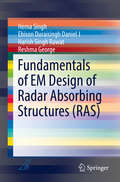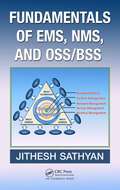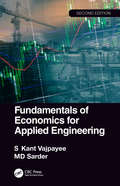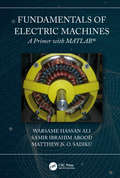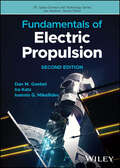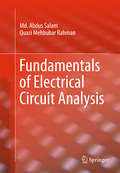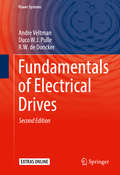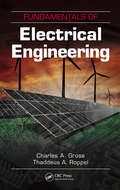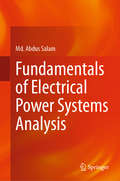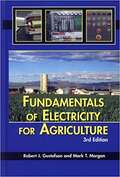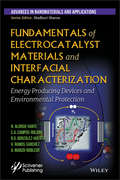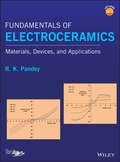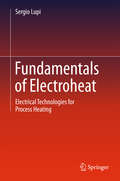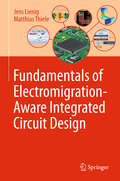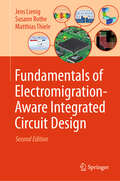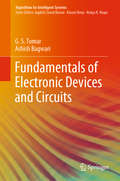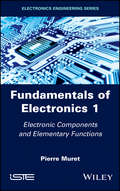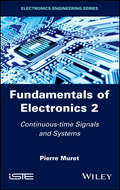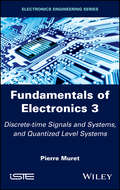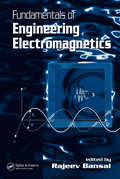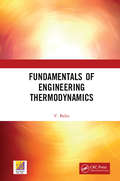- Table View
- List View
Fundamentals of EM Design of Radar Absorbing Structures (RAS)
by Hema Singh Harish Singh Rawat Ebison Duraisingh Daniel J Reshma GeorgeThis book presents a detailed analytical formulation, and step-by-step design procedure for the electromagnetic (EM) design of radar absorbing structures (RAS). It discusses both the equivalent circuit model and Smith chart approach with illustrations to provide a clear understanding of the steps involved in designing multilayered RAS according to the desired specifications. This book is a valuable resource for beginners, academicians, and R&D engineers working in the field of RAS design and development.
Fundamentals of EMS, NMS and OSS/BSS
by Jithesh SathyanIn this era where data and voice services are available at a push of a button, service providers have virtually limitless options for reaching their customers with value-added services. The changes in services and underlying networks that this always-on culture creates make it essential for service providers to understand the evolving business logi
Fundamentals of Economics for Applied Engineering
by S. Vajpayee Md SarderAn easy-to-follow contemporary engineering economics text that helps making sound economic decisions without advanced mathematics. <P><P>This one-semester introduction to the fundamentals of engineering economics provides an overview of the basic theory and mathematics underlying operational business decisions that engineering technology, engineering, and industrial technology students will face in the workplace. A basic knowledge of economics empowers a manager to balance costs with production. <P><P>This new edition of Fundamentals of Economics for Engineering Technologists and Engineers is written in plain language. Concepts have been simplified and kept straightforward with an emphasis on "how to apply" economic principles. <P><P>Practical examples as a tool for managing business data and giving detailed analysis of business operations. throughout the text make good use of Microsoft Excel templates, provided on the book’s companion website, for students. Chapter-end exercises provide discussion and multiple-choice questions along with numerical problems, and a solutions manual and instructor resources is given for adopting instructors.
Fundamentals of Ecotoxicology: The Science of Pollution, Fifth Edition
by Michael C. NewmanThis new edition is revised throughout and includes new and expanded information on natural resource damage assessment, the latest emerging contaminants and issues, and adds new international coverage, including case studies and rules and regulations. The text details key environmental contaminants, explores their fates in the biosphere, and discusses bioaccumulation and the effects of contaminants at increasing levels of ecological organization. Vignettes written by experts illustrate key themes or highlight especially pertinent examples. This edition offers an instructors' solution manual, PowerPoint slides, and supplemental images. Features: Adds all new discussions of natural resource damage assessment concepts and approaches Includes new vignettes written by leading guest authors Draws on materials from 2,500 cited sources, including 400+ new to this edition Adds numerous new entries to a useful glossary of 800+ terms Includes a new appendix discussing Brazilian environmental laws and regulations added to existing appendices outlining U.S., E.U., Chinese, Australian, and Indian environmental laws Fundamentals of Ecotoxicology: The Science of Pollution, Fifth Edition contains a broad overview of ecotoxicology and provides a basic understanding of the field. Designed as a textbook for use in introductory graduate or upper-level undergraduate courses in ecotoxicology, applied ecology, environmental pollution, and environmental science, it can also be used as a general reference for practicing environmental toxicologists.
Fundamentals of Electric Machines: A Primer with MATLAB
by Matthew N. Sadiku Warsame Hassan Ali Samir AboodAn electric machine is a device that converts mechanical energy into electrical energy or vice versa. It can take the form of an electric generator, electric motor, or transformer. Electric generators produce virtually all electric power we use all over the world. Electric machine blends the three major areas of electrical engineering: power, control and power electronics. This book presents the relation of power quantities for the machine as the current, voltage power flow, power losses, and efficiency. This book will provide a good understanding of the behavior and its drive, beginning with the study of salient features of electrical dc and ac machines.
Fundamentals of Electric Power Engineering: From Electromagnetics to Power Systems
by Massimo Ceraolo Davide PoliThis book serves as a tool for any engineer who wants to learn about circuits, electrical machines and drives, power electronics, and power systems basics From time to time, engineers find they need to brush up on certain fundamentals within electrical engineering. This clear and concise book is the ideal learning tool for them to quickly learn the basics or develop an understanding of newer topics. Fundamentals of Electric Power Engineering: From Electromagnetics to Power Systems helps nonelectrical engineers amass power system information quickly by imparting tools and trade tricks for remembering basic concepts and grasping new developments. Created to provide more in-depth knowledge of fundamentals—rather than a broad range of applications only—this comprehensive and up-to-date book: Covers topics such as circuits, electrical machines and drives, power electronics, and power system basics as well as new generation technologies Allows nonelectrical engineers to build their electrical knowledge quickly Includes exercises with worked solutions to assist readers in grasping concepts found in the book Contains “in-depth” side bars throughout which pique the reader’s curiosity Fundamentals of Electric Power Engineering is an ideal refresher course for those involved in this interdisciplinary branch. For supplementary files for this book, please visit http://booksupport.wiley.com
Fundamentals of Electric Propulsion: Ion And Hall Thrusters (JPL Space Science and Technology Series #1)
by Dan M. Goebel Ira Katz Ioannis G. MikellidesFundamentals of Electric Propulsion Understand the fundamental basis of spaceflight with this cutting-edge guide As spacecraft engineering continues to advance, so too do the propulsion methods by which human beings can seek out the stars. Ion thrusters and Hall thrusters have been the subject of considerable innovation in recent years, and spacecraft propulsion has never been more efficient. For professionals within and adjacent to spacecraft engineering, this is critical knowledge that can alter the future of space flight. Fundamentals of Electric Propulsion offers a thorough grounding in electric propulsion for spacecraft, particularly the features and mechanisms underlying Ion and Hall thrusters. Updated in the light of rapidly expanding knowledge, the second edition of this essential guide detailed coverage of thruster principles, plasma physics, and more. It reflects the historic output of the legendary Jet Propulsion Laboratory and promises to continue as a must-own volume for spacecraft engineering professionals. Readers of the second edition of Fundamentals of Electric Propulsion readers will also find: Extensive updates to chapters covering hollow cathodes and Hall thrusters, based on vigorous recent research New sections covering magnetic shielding, cathode plume instabilities, and more Figures and homework problems in each chapter to facilitate learning and retention Fundamentals of Electric Propulsion is an essential work for spacecraft engineers and researchers working in spacecraft propulsion and related fields, as well as graduate students in electric propulsion, aerospace science, and space science courses.
Fundamentals of Electrical Circuit Analysis
by Md. Abdus Salam Quazi Mehbubar RahmanThis book is designed as an introductory course for undergraduate students, in Electrical and Electronic, Mechanical, Mechatronics, Chemical and Petroleum engineering, who need fundamental knowledge of electrical circuits. Worked out examples have been presented after discussing each theory. Practice problems have also been included to enrich the learning experience of the students and professionals. PSpice and Multisim software packages have been included for simulation of different electrical circuit parameters. A number of exercise problems have been included in the book to aid faculty members.
Fundamentals of Electrical Drives
by Andre Veltman Duco W.J. Pulle Rik W. De DonckerThe purpose of this book is to familiarize the reader with all aspects of electrical drives. It contains a comprehensive user-friendly introductory text.
Fundamentals of Electrical Engineering
by Charles A. Gross Thaddeus A. RoppelReal-world engineering problems are rarely, if ever, neatly divided into mechanical, electrical, chemical, civil, and other categories. Engineers from all disciplines eventually encounter computer and electronic controls and instrumentation, which require at least a basic knowledge of electrical and other engineering specialties, as well as associa
Fundamentals of Electrical Power Systems Analysis
by Md. Abdus SalamThis book covers the topic from introductory to advanced levels for undergraduate students of Electrical Power and related fields, and for professionals who need a fundamental grasp of power systems engineering. The book also analyses and simulates selected power circuits using appropriate software, and includes a wealth of worked-out examples and practice problems to enrich readers’ learning experience. In addition, the exercise problems provided can be used in teaching courses.
Fundamentals of Electricity for Agriculture
by Robert J. Gustafson Mark T. MorganAuthored by Robert J. Gustafson and Mark T. Morgan. Designed to assist the reader in attaining a basic understanding of the nature of electricity and in developing skills in solving problems associated with applying electricity in agriculture. <p><p>The first chapters lay the foundation in the basics of electricity. The second portion of the book deals with applications and devices commonly found in agricultural uses of electricity.
Fundamentals of Electro-Optic Systems Design
by Sherman Karp Larry B. StottsUsing fundamentals of communication theory, thermodynamics, information theory and propagation theory, this book explains the universal principles underlying a diverse range of electro-optical systems. From fiber optics and infra-red imaging to free space communications and laser remote sensing, the authors relate key concepts in science and device engineering to practical systems issues. A broad spectrum of coherent and incoherent imaging and communications systems is considered, accompanied by many real-world examples. The authors also present new insights into LIDAR and free space communications and imaging, providing practical guidance on identifying the fundamental limitations of transmission and imaging through deleterious channels. Accompanied by online examples of processed images and videos, this uniquely tailored guide to the fundamental principles underlying modern electro-optical systems is an essential reference for all practising engineers and academic researchers in optical engineering.
Fundamentals of Electrocatalyst Materials and Interfacial Characterization: Energy Producing Devices and Environmental Protection
by Nicolas Alonso-Vante Carlos Augusto Roldan Rosa de Huerta Guadalupe Ramos Sanchez Arturo Manzo RobledoThis book addresses some essential topics in the science of energy converting devices emphasizing recent aspects of nano-derived materials in the application for the protection of the environment, storage, and energy conversion. The aim, therefore, is to provide the basic background knowledge. The electron transfer process and structure of the electric double layer and the interaction of species with surfaces and the interaction, reinforced by DFT theory for the current and incoming generation of fuel cell scientists to study the interaction of the catalytic centers with their supports. The chief focus of the chapters is on materials based on precious and non-precious centers for the hydrogen electrode, the oxygen electrode, energy storage, and in remediation applications, where the common issue is the rate-determining step in multi-electron charge transfer processes in electrocatalysis. These approaches are used in a large extent in science and technology, so that each chapter demonstrates the connection of electrochemistry, in addition to chemistry, with different areas, namely, surface science, biochemistry, chemical engineering, and chemical physics.
Fundamentals of Electroceramics: Materials, Devices, and Applications
by R. K. PandeyThe first textbook to provide in-depth treatment of electroceramics with emphasis on applications in microelectronics, magneto-electronics, spintronics, energy storage and harvesting, sensors and detectors, magnetics, and in electro-optics and acousto-optics Electroceramics is a class of ceramic materials used primarily for their electrical properties. <P><P>This book covers the important topics relevant to this growing field and places great emphasis on devices and applications. It provides sufficient background in theory and mathematics so that readers can gain insight into phenomena that are unique to electroceramics. Each chapter has its own brief introduction with an explanation of how the said content impacts technology. Multiple examples are provided to reinforce the content as well as numerous end-of-chapter problems for students to solve and learn. The book also includes suggestions for advanced study and key words relevant to each chapter. <P><P>Fundamentals of Electroceramics: Materials, Devices and Applications offers eleven chapters covering: 1.Nature and types of solid materials; 2. Processing of Materials; 3. Methods for Materials Characterization; 4. Binding Forces in Solids and Essential Elements of Crystallography; 5. Dominant Forces and Effects in Electroceramics; 6. Coupled Nonlinear Effects in Electroceramics; 7. Elements of Semiconductor; 8. Electroceramic Semiconductor Devices; 9. Electroceramics and Green Energy; 10.Electroceramic Magnetics; and 11. Electro-optics and Acousto-optics. Provides an in-depth treatment of electroceramics with the emphasis on fundamental theoretical concepts, devices, and applications with focus on non-linear dielectrics Emphasizes applications in microelectronics, magneto-electronics, spintronics, energy storage and harvesting, sensors and detectors, magnetics and in electro-optics and acousto-optics Introductory textbook for students to learn and make an impact on technology Motivates students to get interested in research on various aspects of electroceramics at undergraduate and graduate levels leading to a challenging career path. Includes examples and problem questions within every chapter that prepare students well for independent thinking and learning. Fundamentals of Electroceramics: Materials, Devices and Applications is an invaluable academic textbook that will benefit all students, professors, researchers, scientists, engineers, and teachers of ceramic engineering, electrical engineering, applied physics, materials science, and engineering.
Fundamentals of Electroheat
by Sergio LupiThis book provides a comprehensive overview of the main electrical technologies for process heating, which tend to be treated separately in specialized books. Individual chapters focus on heat transfer, electromagnetic fields in electro-technologies, arc furnaces, resistance furnaces, direct resistance heating, induction heating, and high-frequency and microwave heating. The author highlights those topics of greatest relevance to a wide-ranging teaching program, and at the same time offer a detailed review of the main applications of the various technologies. The content represents a synthesis of the extensive knowledge and experience that the author has accumulated while researching and teaching at the University of Padua's Engineering Faculty. This text on industrial electroheating technologies is a valuable resource not only for students of industrial, electrical, chemical, and material science engineering, but also for engineers, technicians and others involved in the application of electroheating and energy-efficient industrial processes.
Fundamentals of Electromigration-Aware Integrated Circuit Design
by Jens Lienig Matthias ThieleThe book provides a comprehensive overview of electromigration and its effects on the reliability of electronic circuits. It introduces the physical process of electromigration, which gives the reader the requisite understanding and knowledge for adopting appropriate counter measures. A comprehensive set of options is presented for modifying the present IC design methodology to prevent electromigration. Finally, the authors show how specific effects can be exploited in present and future technologies to reduce electromigration’s negative impact on circuit reliability.
Fundamentals of Electromigration-Aware Integrated Circuit Design
by Jens Lienig Matthias Thiele Susann RotheThe book provides a comprehensive overview of electromigration and its effects on the reliability of electronic circuits. This second edition has been updated to introduce recent advancements in the understanding of the physical process of electromigration, which gives the reader the knowledge for adopting appropriate counter measures. A comprehensive set of options is presented for modifying the present IC design methodology to prevent electromigration. Finally, the authors show how specific effects can be exploited in present and future technologies to reduce electromigration’s negative impact on circuit reliability.
Fundamentals of Electronic Devices and Circuits (Algorithms for Intelligent Systems)
by G.S. Tomar Ashish BagwariThis book focuses on conceptual frameworks that are helpful in understanding the basics of electronics – what the feedback system is, the principle of an oscillator, the operational working of an amplifier, and other relevant topics. It also provides an overview of the technologies supporting electronic systems, like OP-AMP, transistor, filter, ICs, and diodes. It consists of seven chapters, written in an easy and understandable language, and featuring relevant block diagrams, circuit diagrams, valuable and interesting solved examples, and important test questions. Further, the book includes up-to-date illustrations, exercises, and numerous worked examples to illustrate the theory and to demonstrate their use in practical designs.
Fundamentals of Electronics 1: Electronic Components and Elementary Functions
by Pierre MuretElectronics has undergone important and rapid developments over the last 60 years, which have generated a large range of theoretical and practical notions. This book presents a comprehensive treatise of the evolution of electronics for the reader to grasp both fundamental concepts and the associated practical applications through examples and exercises. This first volume of the Fundamentals of Electronics series comprises four chapters devoted to elementary devices, i.e. diodes, bipolar junction transistors and related devices, field effect transistors and amplifiers, their electrical models and the basic functions they can achieve. Volumes to come will deal with systems in the continuous time regime, the various aspects of sampling signals and systems using analog (A) and digital (D) treatments, quantized level systems, as well as DA and AD converter principles and realizations.
Fundamentals of Electronics 2: Continuous-time Signals and Systems
by Pierre MuretThis book presents a synthesis of Electronics through keynotes which are substantiated in three volumes. The first one comprises four chapters devoted to elementary devices, i.e. diodes, bipolar transistors and related devices, field effect transistors and amplifiers. In each of one, device physics, non linear and linearized models, and applications are studied. The second volume is devoted to systems in the continuous time regime and contains two chapters: one describes different approaches to the transfer function concept and applications, and the following deals with the quadripole properties, filtering and filter synthesis. The third volume presents the various aspects of sampling systems and quantized level systems in the two last chapters.
Fundamentals of Electronics 3: Discrete-time Signals and Systems, and Quantized Level Systems
by Pierre MuretFundamentals of Electronics 3: Discrete-time Signals and Systems, and Quantized Level Systems by Pierre Muret
Fundamentals of Engineering Electromagnetics
by Rajeev BansalElectromagnetics is too important in too many fields for knowledge to be gathered on the fly. A deep understanding gained through structured presentation of concepts and practical problem solving is the best way to approach this important subject. Fundamentals of Engineering Electromagnetics provides such an understanding, distilling the most important theoretical aspects and applying this knowledge to the formulation and solution of real engineering problems.Comprising chapters drawn from the critically acclaimed Handbook of Engineering Electromagnetics, this book supplies a focused treatment that is ideal for specialists in areas such as medicine, communications, and remote sensing who have a need to understand and apply electromagnetic principles, but who are unfamiliar with the field.Here is what the critics have to say about the original work"…accompanied with practical engineering applications and useful illustrations, as well as a good selection of references … those chapters that are devoted to areas that I am less familiar with, but currently have a need to address, have certainly been valuable to me. This book will therefore provide a useful resource for many engineers working in applied electromagnetics, particularly those in the early stages of their careers."-Alastair R. Ruddle, The IEE Online"…a tour of practical electromagnetics written by industry experts … provides an excellent tour of the practical side of electromagnetics … a useful reference for a wide range of electromagnetics problems … a very useful and well-written compendium…"-Alfy Riddle, IEEE Microwave MagazineFundamentals of Engineering Electromagnetics lays the theoretical foundation for solving new and complex engineering problems involving electromagnetics.
Fundamentals of Engineering Plasticity
by William F. HosfordThis book is ideal for those involved in designing sheet metal forming processes. Knowledge of plasticity is essential for the computer simulation of metal forming processes, and understanding the advances in plasticity theory is key to formulating sound analyses. In this book, William Hosford makes the subjects simple by avoiding notations used by specialists in mechanics. R. Hill's authoritative book, Mathematical Theory of Plasticity (1950), presented a comprehensive treatment of continuum plasticity theory up to that time; although much of the treatment in this book covers the same ground, it focuses on more practical topics. Hosford has also included recent developments in continuum theory, including a newer treatment of anisotropy that has resulted from calculations of yielding based on crystallography, analysis of the role of defects, and forming limit diagrams. This text also puts a much greater emphasis on deformation mechanisms, and includes chapters on slip and dislocation theory and twinning.
Fundamentals of Engineering Thermodynamics
by V. BabuThis book deals with all the concepts in first level Thermodynamics course. Numerous examples are given with the objective of illustrating how the concepts are used for the thermodynamic analysis of devices. Please note: T&F does not sell or distribute the Hardback in India, Pakistan, Nepal, Bhutan, Bangladesh and Sri Lanka
